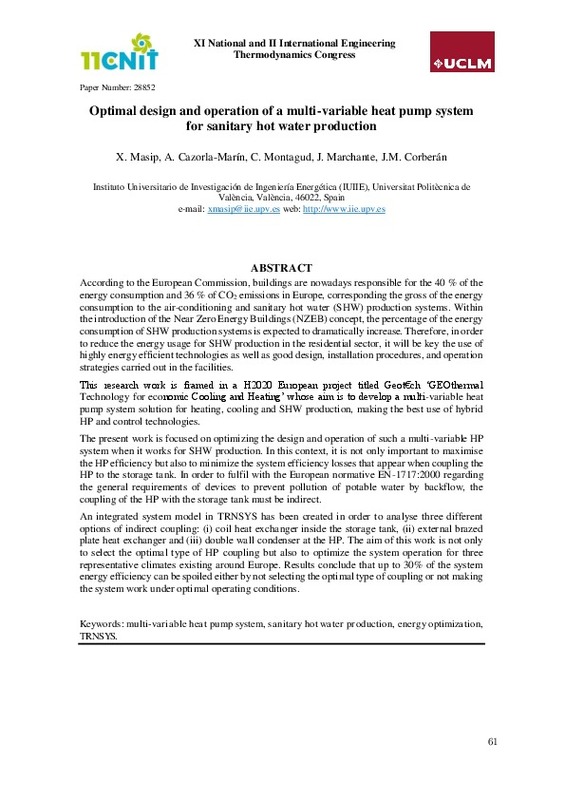JavaScript is disabled for your browser. Some features of this site may not work without it.
Buscar en RiuNet
Listar
Mi cuenta
Estadísticas
Ayuda RiuNet
Admin. UPV
Optimal design and operation of a multi-variable heat pump system for sanitary hot water production
Mostrar el registro sencillo del ítem
Ficheros en el ítem
| dc.contributor.author | Masip Sanchis, Ximo
|
es_ES |
| dc.contributor.author | Cazorla-Marín, Antonio
|
es_ES |
| dc.contributor.author | Montagud- Montalvá, Carla
|
es_ES |
| dc.contributor.author | Marchante-Avellaneda, Javier
|
es_ES |
| dc.contributor.author | Corberán, José M.
|
es_ES |
| dc.date.accessioned | 2019-10-23T08:41:12Z | |
| dc.date.available | 2019-10-23T08:41:12Z | |
| dc.date.issued | 2019 | |
| dc.identifier.isbn | 978-84-09-11635-5 | |
| dc.identifier.uri | http://hdl.handle.net/10251/129321 | |
| dc.description.abstract | According to the European Commission, buildings are nowadays responsible for the 40 % of the energy consumption and 36 % of CO2 emissions in Europe, corresponding the gross of the energy consumption to the air-conditioning and sanitary hot water (SHW) production systems. Within the introduction of the Near Zero Energy Buildings (NZEB) concept, the percentage of the energy consumption of SHW production systems is expected to dramatically increase. Therefore, in order to reduce the energy usage for SHW production in the residential sector, it will be key the use of highly energy efficient technologies as well as good design, installation procedures, and operation strategies carried out in the facilities. This research work is framed in a H2020 European project titled Geot€ch `GEOthermal Technology for economic Cooling and Heating¿ whose aim is to develop a multi-variable heat pump system solution for heating, cooling and SHW production, making the best use of hybrid HP and control technologies. The present work is focused on optimizing the design and operation of such a multi-variable HP system when it works for SHW production. In this context, it is not only important to maximise the HP efficiency but also to minimize the system efficiency losses that appear when coupling the HP to the storage tank. In order to fulfil with the European normative EN-1717:2000 regarding the general requirements of devices to prevent pollution of potable water by backflow, the coupling of the HP with the storage tank must be indirect. An integrated system model in TRNSYS has been created in order to analyse three different options of indirect coupling: (i) coil heat exchanger inside the storage tank, (ii) external brazed plate heat exchanger and (iii) double wall condenser at the HP. The aim of this work is not only to select the optimal type of HP coupling but also to optimize the system operation for three representative climates existing around Europe. Results conclude that up to 30% of the system energy efficiency can be spoiled either by not selecting the optimal type of coupling or not making the system work under optimal operating conditions. | es_ES |
| dc.description.sponsorship | The present work has been supported by the Ministerio de Educación, Cultura y Deporte inside the programme ‘Formación de Profesorado Universitario (FPU15/03476)’ | es_ES |
| dc.format.extent | 11 | es_ES |
| dc.language | Inglés | es_ES |
| dc.publisher | Universidad de Castilla-La Mancha | es_ES |
| dc.rights | Reserva de todos los derechos | es_ES |
| dc.subject | Multi-variable heat pump system | es_ES |
| dc.subject | Sanitary hot water production | es_ES |
| dc.subject | Energy optimization | es_ES |
| dc.subject | TRNSYS | es_ES |
| dc.subject.classification | MAQUINAS Y MOTORES TERMICOS | es_ES |
| dc.subject.classification | TERMODINAMICA APLICADA (UPV) | es_ES |
| dc.title | Optimal design and operation of a multi-variable heat pump system for sanitary hot water production | es_ES |
| dc.type | Capítulo de libro | es_ES |
| dc.type | Comunicación en congreso | es_ES |
| dc.relation.projectID | info:eu-repo/grantAgreement/MECD//FPU15%2F03476/ES/FPU15%2F03476/ | es_ES |
| dc.rights.accessRights | Abierto | es_ES |
| dc.contributor.affiliation | Universitat Politècnica de València. Departamento de Termodinámica Aplicada - Departament de Termodinàmica Aplicada | es_ES |
| dc.description.bibliographicCitation | Masip Sanchis, X.; Cazorla-Marín, A.; Montagud- Montalvá, C.; Marchante-Avellaneda, J.; Corberán, JM. (2019). Optimal design and operation of a multi-variable heat pump system for sanitary hot water production. Universidad de Castilla-La Mancha. 61-71. http://hdl.handle.net/10251/129321 | es_ES |
| dc.description.accrualMethod | S | es_ES |
| dc.relation.conferencename | Congreso Nacional de Ingeniería Termodinámica (CNIT) | es_ES |
| dc.relation.conferencedate | Junio 12-14,2019 | es_ES |
| dc.relation.conferenceplace | Albacete, Spain | es_ES |
| dc.description.upvformatpinicio | 61 | es_ES |
| dc.description.upvformatpfin | 71 | es_ES |
| dc.type.version | info:eu-repo/semantics/publishedVersion | es_ES |
| dc.relation.pasarela | S\390471 | es_ES |
| dc.contributor.funder | Ministerio de Educación, Cultura y Deporte | es_ES |






